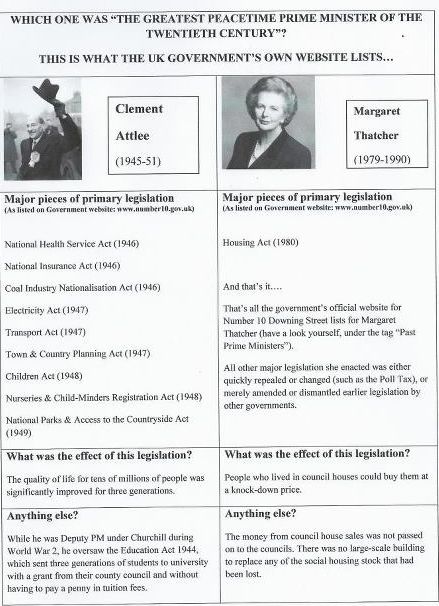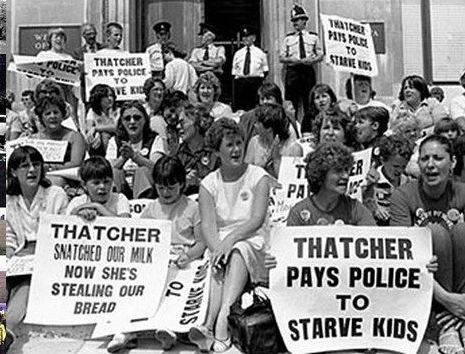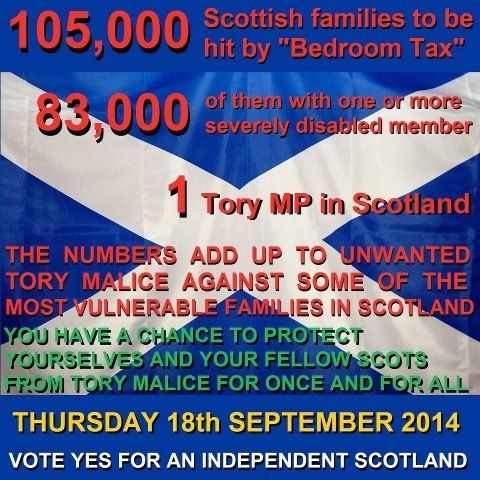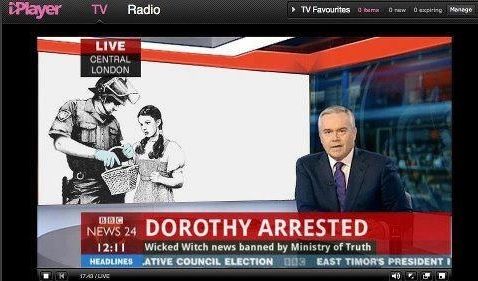(2 pm. – promoted by ek hornbeck)
The state funding of a funeral for Margaret Thatcher (estimated cost £10m) and the claims that she was the greatest post-war prime minister mourning for “Boadicea in pearls” (yes, I couldn’t make that up) in the Commons is still not ringing true on the streets of Glasgow, Brixton, Leeds, and Bristol where impromptu parties celebrating her death sprung up; the police are so worried that they have started monitoring social media sites fearing demonstrations at the funeral.

Given that the last funeral of this type for a politician (as opposed to a member of the royal family) was held for Winston Churchill, the “everything but state funeral in name” is causing a bit of a fuss, especially as austerity is taking food out of the mouths of the poor and disabled. The arrogance and cynicism of the ruling class in Britain in the face of the misery they are causing is making even the most resigned of the British population to grumble.
Clement Attlee’s legacy of social cohesion and mutual support is destroyed and ignored by those who are bringing Maggie’s dreams to fruition. Thatcher was a politician who argued that there was no such thing as society and championed individualism, a politician who destroyed the manufacturing and industrial sectors in Britain, who worked very hard to destroy the union movement and the rights of workers in Britain. She undercut and then enabled the sell-off of social housing and eliminated rent control for private housing, which is part of the problem underlying the lack of social housing today, along with the continuing government commitment to private ownership. She is lauded as the so-called greatest peacetime Prime Minister of the 20th century, yet called Nelson Mandela a terrorist, while embracing Suharto and Pinochet. Let’s not forget the 10 Irish prisoners who died in 1981 during a hunger strike while demanding political prisoner rather than criminal status. Let’s also consider the last-gasp of British colonialism in her defense of the Malvinas, while ignoring the US invasion of Grenada.
A quick comparison between the two of them should settle this discussion handily:

In the midst of all this revisionist history, my complaint that some feminists are calling a woman who detested feminists and feminism “A feminist Icon” seems almost an after-thought. I really do question why President Obama wants his beloved daughters to see this woman as worthy of emulating due to her “shattering the glass ceiling” while she brought the roofs down on other women. Should they decide to shatter the glass ceiling themselves, I hope they remember not to destroy and disparage the lives of those below them.
The recall of Parliament to laud Thatcher and her accomplishment produced little but dribble; however, a big Thank You to Glenda Jackson for at least speaking the truth!
My only consolation is that she will not be alive to see her wildest dreams come to fruition; however her legacy lives on. The fight against her legacy has been on-going not only in Britain but in the whole world. Unfortunately, her right-wing policies are those that are dominant in the advanced capitalist world today, and have been thrust by the World Bank on countries throughout the capitalist emergent economies and periphery. This fight must not cease, and indeed its intensity must increase if we are to destroy neoliberalism, which is threatening workers’ rights and incomes and the lives of the poor and disabled in the name of protecting the interests of capitalism and capitalists on the back of the majority living in those countries. In Tory Britain, Thatcher’s process of dismantling society to benefit the few to the detriment of the majority, continues at speed; the question of whether this can be stopped and reversed depends on the willingness of the majority of Britain to fight for the universality of the social welfare state.

1. The Attack on the State Sector and the Universal Social Welfare State in Britain
On April 1st (which is a rather fitting day when you think of it, though like most April fool’s jokes it is not at all funny,) all of the cuts introduced by the Con-Dem government came into effect.These include wide-ranging cuts in benefits across the social welfare NHS under EU competition law (see also: http://www.coalitionofresistance.org.uk/2013/03/government-to-amend-controversial-nhs-competition-rules/, cuts in pensions, frozen state sector workers wages, job loss throughout the state sector at all levels, closures of public services due to central government cutbacks and the undermining of public education through the forced introduction of academies (similar to charter schools in the US) even at the primary school level.
Cuts in benefits:
While explaining cuts in benefits; what needs to be understood is that unlike the US, there is a universal social welfare state in Britain and only part of it was means tested. For example, child benefits used to be given independent of income and wealth. The extension of means testing and the general attack on the poorest and disabled is an important part of the discussion, as benefits guaranteed to others beyond the poorest and disabled have also been introduced over time. Now the system is being shifted from one which is universal to one more like that in the US where only the poorest are covered, and then very poorly indeed.
A general cap to the amount of benefits claimants can receive has been introduced; £500/week for those households with couples and lone parent households (single adult household with no children are capped at £350/week). This means that the cumulative total of all benefits are capped including rent (and housing benefit), food, disability payments, and child benefits. While those numbers sound like a lot of money, they are not when rent is included. Additionally, benefits and pensions have been re-indexed from the Retail Price Index to the Consumer Price Index (CPI), with the main difference between the two reflecting housing costs. As such, increases in benefits and pensions will be lower due to the use of the CPI and does not reflect the true costs of living. Added to this is the 1% cap on increases in benefits which means that benefits do not even keep pace with inflation, even measured by the woefully inadequate CPI.
Most of these cuts are limits based upon the Bethamite principle of Less Eligibility (that is, those on benefits or on poor relief must have worse standards of living than those doing independent work) where those on relief/benefits cannot earn more than those that are in work. Supposedly, it is to guarantee the importance of the principle of work. However, we have an additional consideration that must be addressed: increased precariousness of work, low wages especially for unskilled labour (which comprise the majority of jobs), and high unemployment means that wages are already too low.
The government has been touting the possibility of differential wages for areas of high unemployment. Some regions would actually have lower wage rates irrespective of wage contract and negotiations. With wages and incomes falling and the introduction of flexible labour markets, the wages of working people are often below the minimum wage, which is alreadynot a living wage. Given the principle of lesser eligibility, people dependent upon benefits must have lower incomes than those that are working which are already below social subsistence level. Social subsistence has been undermined and the incomes of the poor are falling towards physical (i.e., biological) subsistence levels.
But what happens when there are no jobs as has been the case since the crash of 2008?
If there are few jobs, labelling the unemployed as lazy slackers only serves to demonise them. Divide and rule is effective as a mechanism to split people. However, what is essential to understand is that lowering benefits to force the unemployed into work will not create jobs, it only impoverishes people. Moreover, low levels of productivity in Britain indicate that some companies are trying to keep workers on, rather than sacking them, while waiting for an upturn in the economy. What that means is that if (and that is a big if) the economy picks up, employment will not necessarily rise as bosses may then make workers work harder rather than hiring new people. As such, better opportunities for the unemployed may not come back for a long time, if they ever do come back.
Transition in job-seekers benefits linked to “voluntary” labour and increased numbers being sent to mandatory work activity aka Workfare:
Initially introduced under New Labour, the mandatory work activity was used to force those on long-term benefits to get work training. Under the current government, this was extended to include “volunteering” often in commercial companies for no pay beyond benefits received under threat of loss of benefits. The government was taken to court by two of these “volunteer” workers and lost the case. However, the claim of forced labour by those who brought the suit was rejected; it is an understatement to say that this is a questionable decision as workers were threatened with commensurate loss of benefits affecting themselves and their families. That is, almost by definition, “forced labour.” The case was rejected as the Secretary of Work and Pensions, Iain Duncan Smith, to mandate this programme did so without parliamentary approval.
The courts also said that those whose benefits were suspended should be repaid; this amounted to 250,000 jobseekers, forced into “voluntary” labour and who were then sanctioned, receiving £130m in rebates. A bill to deny these people the rebate went before Parliament. Leadership in the Labour party, instead of opposing it, abstained, while 44 Labour MPs broke ranks with the party whip and did vote against it. (See: http://welfarenewsservice.com/labour-abstention-on-workfare-bill-prompts-party-infighting/#.UWgcQLWmgwo; http://graduatefog.co.uk/2013/2477/work-programme-jobseekers-denied-compensation-docked-benefits/; http://johnnyvoid.wordpress.com/2013/03/20/labours-workfare-shame-a-new-low-for-the-party-that-pretends-to-care-about-the-poor/). It was this move on the part of the leadership of the Labour party, and both Liam Byrne (Shadow Secretary of work and pensions) and Ed Milliband’s insistence on linking work to benefits, that led to many shocked supporters finally realising that they could not count on the Labour party.
Disability Benefits:
The replacement of Incapacity Benefits with Employment Support Allowance (ESA) includes an assessment by a private company ATOS to ascertain whether you are truly disabled (£Up to £105.05/wk) or can be placed in a Work Related Activity Group (WRAG) (£Up to £99.15/wk) or belong on Job Support Allowance (££56.80/wk). During the first 13 weeks after application for ESA, you can only get £56.80 (if you are under 25) and £71.70 (if you are over 25) (see: https://www.gov.uk/employment-support-allowance/what-youll-get).
There were two forms of Incapacity benefits: 1) contribution based for temporary illnesses and sickness (contributory); 2) non-contributory based upon disability.
If you are rejected for ESA, then you are supposedly eligible for Job-seekers allowance (£56.80/week) if you are over 18 and able and available for work (which many people that are wrongly rejected for ESA are not); you will not be eligible for contributory disability benefits as you haven’t been contributing to the fund. However, many people who are wrongly rejected for ESA are not available for work due to their inability to work. ATOS assessments are notoriously unrealistic and the vast majority of decisions are overturned upon appeal (where, of course, you are not getting the correct level of benefits during the period of appeal)
The elimination of Disability Living Allowance (DLA) meant to help you cope with added expenses for being disabled and its replacement by Personal Independence Payment(PIP) and the fact that you must face an ATOS assessment (along with the elimination of the middle rate of DLA benefit of £51.85/wk) will certainly create additional hardship. How much you get depends upon your mobility and the assistance you need (see: https://www.gov.uk/disability-living-allowance-dla-rates). Moreover, Carer’s benefits are tied to receipt of DLA (Carer’s Allowance is £58.45 a week to help you look after someone with substantial caring needs), so if the person you are caring for loses DLA or PIP, carer’s benefits will also be lost even though carer’s responsibilities are not eliminated). If you are over 65, instead of applying for PIP you will need to apply for AA which does not contain a mobility portion. Finally, the elimination of the Independent Living Fund (helping people with disabilities live independently) will add extreme hardship to those people with disabilities trying to live independently in the community rather than in residential homes or with their families.

Housing Benefits cuts:
Cuts have been introduced to the amount given for housing benefit; the purpose of these cuts is to clear out the centre of London for the wealthy and to shift those who are on housing benefits to outer boroughs. For those in social housing, the benefit cap of £500 applies; you cannot get any more money than that per month. If you are living in private accommodation and getting housing benefits, according to Shelter:
“your housing benefit will be ‘capped’ according to the size of your home. You will only get housing benefit up to a maximum of:
• £250 pw for 1 bedroom
• £290 pw for 2 bedrooms
• £340 pw for 3 bedrooms
• £400 pw for 4 bedrooms or for any property with more than 4 bedrooms.
This is the maximum amount you will get even if you have a larger property (http://england.shelter.org.uk/__data/assets/pdf_file/0009/599391/Housing_benefit_changes_-_are_you_affected_Nov_2012.pdf).”
Bedroom Tax:
The Bedroom tax is being laid against those on housing benefit and in social housing, with more bedrooms than the state deems they need. It’s stated purpose is to free up insufficient numbers of housing for larger families.
According to Shelter:
“From April 2013, council tenants and housing association tenants will have their housing benefit entitlement reduced if the council decides their home is too big for their needs. This is often called the ‘bedroom tax’ or ‘under-occupancy rule’.
The amount of rent you can claim housing benefit for will be reduced if you have one or more spare rooms. This means you will have to pay more of the rent yourself.
The amount of rent used to calculate how much housing benefit you’re entitled to (your ‘eligible rent’) will be cut by a fixed percentage:
• 14% if you have one extra bedroom.
• 25% if you have two or more extra bedrooms. (http://england.shelter.org.uk/get_advice/housing_benefit_and_local_housing_allowance/changes_to_local_housing_allowance/housing_benefit_changes_2013).”
The shortage of housing with larger numbers of rooms derives from both the sale of social housing under Thatcher, insufficient building of social housing since then, and the concentration on private housing. Money is either to be taken out directly from housing benefits at the source or to be implemented at local levels if a recipient of housing benefit has extra rooms. This clearly will affect those who are disabled, as many have an adapted room for them to sleep in while carers (often spouses) sleep in the extra room; it will also affect grandparents who often care for their grandchildren, it is unclear if it will affect those who are foster parents as this is being further examined by the government.
Contrary to comparisons, this tax has no relationship to the Window Tax laid against the wealthy to raise revenue for the government or the Poll Tax which affected everyone and was far easier to mobilise against. This tax is specifically aimed at those receiving housing benefits while living in social housing as they view that those living in privately rented accommodation already make these decisions normally. According to the National Housing Federation, the proposal will affect an estimated 660,000 working-age social tenants – 31% of existing working-age housing benefits claimants in the social sector. 340,000 of these are single women (51%), 160,000 single men and 160,000 couples. Of those 660,000 affected, 420,000 (63%) are people with disabilities (see the equality assessment: http://www.dwp.gov.uk/docs/eia-social-sector-housing-under-occupation-wr2011.pdf).
If this is an attempt to raise money, it is one of the most regressive taxes ever implemented, but it is not an attempt to raise revenue for the government. It is negligible – £14 per week, on average, for 660,000 people amounts to £9,240,000/week (£480,480,000/yr) from the very poorest: mostly single mothers and disabled people. (One week’s benefit theft amounts to less than the cost of Thatcher’s funeral, but I am sure that they can make up the costs); see http://www.dwp.gov.uk/docs/social-sector-housing-under-occupation-wr2011-ia.pdf). That amount compared to a government’s budget is essentially peanuts. This is an attempt to force people out of larger flats instead of building further social housing. All it will do is take money from those who cannot afford to lose anything, already.
Moreover, if they wanted to raise revenue, certainly they could earn a lot more introducing a financial transactions tax, or force corporations that are tax avoiding or evading to pay; just think how much they could have raised if they didn’t cut corporate tax rates and the 50% tax on those earning over £150,000/year? Even more so, think how much more they could raise if they actually got their hands on the tax money withheld by individuals due to avoidance and evasion if they closed down the tax havens which the extremely wealthy use; but that would affect themselves and their friends and that is not something that this government wants to consider.

Cuts to council tax benefits:
Unlike the bedroom tax, council tax benefits are widely accessed throughout the country. In fact, according to The Guardian, it is the most widely accessed means-tested benefit, with around 5.9m recipients. The central government has shifted responsibility to local councils to decide what to do while, at the same time, limiting what they can decide when it comes to who can and cannot be affected. Council tax benefits are forced to be cut by local governments (that is where they come from) and those who were formally exempted from paying will now be forced to pay. Various local councils have tried to address this in several ways, some choosing to protect the poor by cutting rebates to those living in more expensive housing, some spreading it equally meaning that the poor will have to come up with some more money to pay for the elimination of council tax benefits (http://www.guardian.co.uk/commentisfree/2013/feb/21/council-tax-benefit-cuts and http://www.guardian.co.uk/society/2013/feb/27/low-incomes-council-tax-local)). It needs to be understood that while we are talking about something like £120/year, if you are living on £71/week, that is going to affect the incomes of the poorest.
Obviously, these cuts are cumulative and if you are among the unlucky losing benefits for being disabled, for example, you will be hit several times as this extraction from a chart from DEMOS shows:
| Benefit | Cuts Affected by | Number of Disabled People Affected |
Loss per person by 2018 | Total loss as a group |
|
|---|---|---|---|---|---|
| DOUBLE WHAMMY |
ESA (WRAG) | Uprating by 1% of ESA; Time limitation of C-WRAG | 88,000 | £15506 | £1.3bn |
| TRIPLE WHAMMY | DLA and ESA (WRAG) | Uprating by 1% of ESA WRAG Time limitation of C-WRAG Replacement of DLA with |
26,600 | £17097-£23,461 | £6.2bn |
| TRIPLE WHAMMY | DLA and under occupancy in social housing (bedroom tax) |
A cut in housing benefit due to under-occupation
A loss of DLA due to the introduction of PIP A reduction in housing benefit due to uprating by A reduction in DLA due to |
264,600 | £6,280 | £1.66bn |
2. Fight, Fight, Fight!
The fight-back against this government, and for that matter, against the capitulation of New Labour, is increasing as hardship is extending and people are understanding that the government’s programmes are not really concerned with beating back government debt and deficit; it is about lowering living standards of the majority, undermining the social welfare state, privatising the NHS and privatisation of services, all of which are based upon a right-wing ideological agenda.
Union Action:
There are many Trade union actions. But, there is something new. For the first time since 1926, the word General Strike is being discussed seriously among unions. Unite called for a General Strike and there seems to be support among UNISON(see also: http://www.ft.com/cms/s/0/23168ae6-9ba3-11e2-8485-00144feabdc0.html#axzz2QGwwCmGf). The question of whether it is legal is being examined, as well as, whether enough support can be found to make it a real general strike. Shall we say the Labour party is not amused?!
Teachers’ unions are discussing the next phase of the fight-back, with the two largest unions, NUT and NASUWT preparing for coordinated industrial action. This is important as NASUWT did not participate in the one-day strike last year which was supported by ATL and NUT, so this is a shift in alignments.
Movements
What is absent in Britain is a broad based national movement uniting employed and unemployed and various localised groups fighting austerity. However, that does not mean that anti-austerity activity is not occurring. From Councillors against the Cuts, local anti-cuts groups, to campaigns focussed on the impact of the cuts on the disabled (DPAC and Black Triangle Campaign) and those on benefits, to various groups fighting to protect the NHS and hospitals facing loss of departments (e.g., Lewisham, Whittington Hospital in Islington, Croydon, Bridlington in the Northeast of England, Mid-Wales), these movements exist and have been fighting the cuts. Most of them are grass-roots based organisations. For example, the Anti-Bedroom tax campaign is a broad grassroots campaign across Britain in response to the bedroom tax. Moreover, it is a campaign in which numbers of anarchists and those using direct action (UK Uncut) are participating and fighting (see: http://combatbedroomtax.blogspot.co.uk/. There was also an occupation at Sussex University to protest privatisation of provision of services and commensurate job losses that lasted for 7 weeks; they were evicted on Good Friday.
“This is a call to all those millions of people in Britain who face an impoverished and uncertain year as their wages, jobs, conditions and welfare provision come under renewed attack by the government. With some 80% of austerity measures still to come, and with the government lengthening the time they expect cuts to last, we are calling a People’s Assembly Against Austerity to bring together campaigns against cuts and privatisation with trade unionists in a movement for social justice. We aim to develop a strategy for resistance to mobilise millions of people against the Con Dem government.
The assembly will provide a national forum for anti-austerity views which, while increasingly popular, are barely represented in parliament. A People’s Assembly can play a key role in ensuring that this uncaring government faces a movement of opposition broad enough and powerful enough to generate successful co-ordinated action, including strike action. The assembly will be ready to support co-ordinated industrial action and national demonstrations against austerity, if possible synchronising with mobilisations across Europe. The People’s Assembly Against Austerity will meet at Central Hall, Westminster, on 22 June, 2013 (http://www.guardian.co.uk/business/2013/feb/05/people-assembly-against-austerity)”
Initiated by the Coalition of Resistance, the people’s assembly is an attempt to bring together the unions and various anti-cuts groups and individuals opposed to austerity. 1,664 have already registered and paid for the People’s Assembly. It is estimated that about 2-3000 people will be taking part in the event.
The question arises, what comes after this event? Will a national movement be able to be built? Again, much will depend on willingness of the participants to do this and the ability to provide a democratic platform to which all participants can have input and whether participants think what the best way forward will be.
Electoral Parties
Outside of the mainstream, there are three national electoral parties that have existed in Britain representing an opposition. There are local parties like Lewisham People Before Profits (http://www.peoplebeforeprofit.org.uk/lewisham), but I will concentrate on the national parties. One is the Green Party, the other is the Trade Union and Socialist Coalition (TUSC) and the third is George Galloway’s Respect party.
The Green party does not have an explicitly socialist agenda. In fact at local level where they have had some success, they have introduced cuts which have led to some members of the Green Left leaving the group. They have a single Member of Parliament, Caroline Lucas who has taken an anti-austerity position in the Commons (for an interesting analysis of the Green Party, here is Sean Thompson.
TUSC is a coalition of far left parties (Socialist Party, Socialist Workers Party and Independent Socialist Network) with some left unions (Rail, Maritime and Transport, Fire Brigades Union) run under a federated structure where those on the leadership (made up of representatives of the various groups) have a veto over proposals. Its electoral success has been minimal and a movement supporting it between elections is literally non-existent. In fact, in the Eastleigh by-election for Chris Huhne’s seat (in a constituency in which the major players have traditionally been the Tories and Lib Dems and where they probably should not have run and let the National Health Action party run for the opposition), they only got 62 votes. This election also heralded the rise of the right-wing UK Independence Party (UKIP) as a serious player in first-past-the-post general elections, coming in second, edging past the Conservative Party. TUSCs lack of success during this period is a serious problem.
And then there is Respect … Respect has become based around George Galloway’s personal charisma. Galloway’s incredible success in getting elected in Bradford raised the issue of whether this could be replicated elsewhere. And then we were treated to Galloway’s comments about rape and Julian Assange which infuriated women (causing at least one female political candidate to leave the party) and made it quite clear that Respect was not the vehicle that could lead a broad left unity party. It still exists and still has a strong anti-imperialist perspective, but it cannot form the basis of a democratic broad left opposition.
Additionally, a new party has appeared on the ballots called the National Health Action Party (NHAP). This party has been deliberately set up to protect the NHS which is facing an attack by the government and was formed by healthcare professionals trying to preserve the NHS. It may have a broader anti-cuts agenda, but this is still under discussion. Primarily, this is a party of opposition to attempts at privatisation of the NHS. In the Eastleigh by-election, which was the first election they ran in, they received 392 votes.

New Directions
However, the fight against neoliberalism is taking some new turns with the beginnings of discussions towards the formation of a broad left party in Britain. In the absence of a coherent electoral opposition to neoliberalism, which has now been adopted by all three main parties, the question arises how can continued privatisation of the state sector, including the NHS, and the attack on the universal nature of the social welfare state be stopped and what can a left unity movement articulate as a positive programme?
The Left Unity discussions began with a call by Kate Hudson and Andrew Burgin (http://leftunity.org/left-unity-solidarity-debate-action/) in February. Several hard-left groups and individual members of the hard left answered this call.

Following the screening of his movie about Attlee’s Britain “The Spirit of ’45”, in a Q&A, Ken Loach made an appeal to begin discussions for the formation of a new broad left political party. Within a few days there were 2000 signatories, within a week, groups started to be formed. There are now over 8000 signatures to Ken Loach’s appeal and over 80 groups around Britain (including in Scotland and Wales), meetings are being conducted and discussion and debate has begun among hard-left groups and individuals. The groups are autonomous, with some led by members of Old Labour disgusted by the actions and beliefs of New Labour and some led by revolutionary socialists. Points of agreement so far are rejection of neoliberalism and the mainstream political discourse and the need for a broad left party. Specifically, the discussion is explicitly addressing whether a broad left party can be created. Excitingly, this is being driven from the bottom, membership will be individual, and a transitional leadership composed of leaders of local groups, individuals from various left organisations, and independent leftists has been created. A national meeting is planned for early this summer.

From its beginnings, the importance of women’s rights and women’s participation in the movement have been demanded; the importance of ensuring that the voices and participation of people of colour have been central to the debate and discussions. Finally, the Left has stood next to those struggling for the rights of the disabled – this has been recognised by ensuring that disabled people against the cuts are represented on the transitional organising committee. The recognition of race, class and gender as primary considerations is a major step forward. The importance of international solidarity, ecosocialism and democracy in the group also are central organisational concepts. On an explicitly socialist platform, they are not only trying to create a united broad left opposition, but will articulate a positive programme for change. Combined with an anti-austerity platform, a broad left party could serve to offer those fed up with the neoliberalism of the 3 main parties, and the right-wing shift of electoral political debate in Britain, a place to cast a vote for a truly left-wing party.
Needless to say, the whole left is not behind the movement. The Trade Unions themselves have not climbed on board as many are still wed to the Labour Party, but hopefully, if the movement develops, they will join. Some groups think that abandoning the Labour party is not appropriate, at this time. Other individuals (e.g., such asOwen Jones), are calling for a fight to shift the Labour party back to the left. Then there are the discussions of the hard-left parties (specifically the SP, SWP and Counterfire), which are wonderfully synthesised by Dave Kellaway here, if you are interested in the discussions of hard-left organisations on Left Unity.

I admit to going out into the back garden (mostly to spare my neighbours and passers-by my horrible singing) to sing “Ding Dong the Witch Is Dead” the day that Thatcher died. Many others did as well. Yes, it was politically incorrect, but sometimes we cannot help ourselves when we get carried away in the moment. Honestly, this horrible woman has more of a link with wicked witches than she does with being a feminist icon (i.e., nothing). In a really bizarre twist of the Thatcher mourning struggle, “Ding Dong the Witch is Dead”, which has risen rapidly in the music charts will not be played in full on the BBC Radio 1 official chart show, even though it is at number 2 in the charts. Rather than banning the song, they are playing a clip of 4-5 seconds, ignoring that it is the people’s choice in a music chart show. It is being treated as though Judy Garland was somehow expressing treason in the song written so long ago.
However, the death of Thatcher will not stop the neoliberal attack on the state sector and the universal social welfare state. Will Left Unity be successful at stopping it? Things are still in flux, but they are moving rapidly. We shall see what happens, but for the first time in quite a while, I am hopeful!


1 comments
Her legacy will haunt us forever.